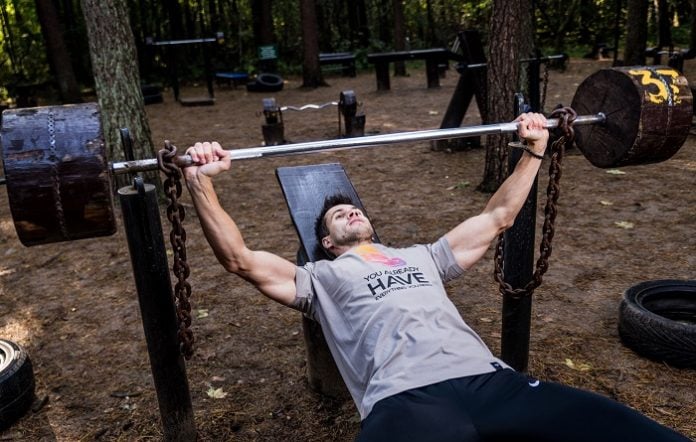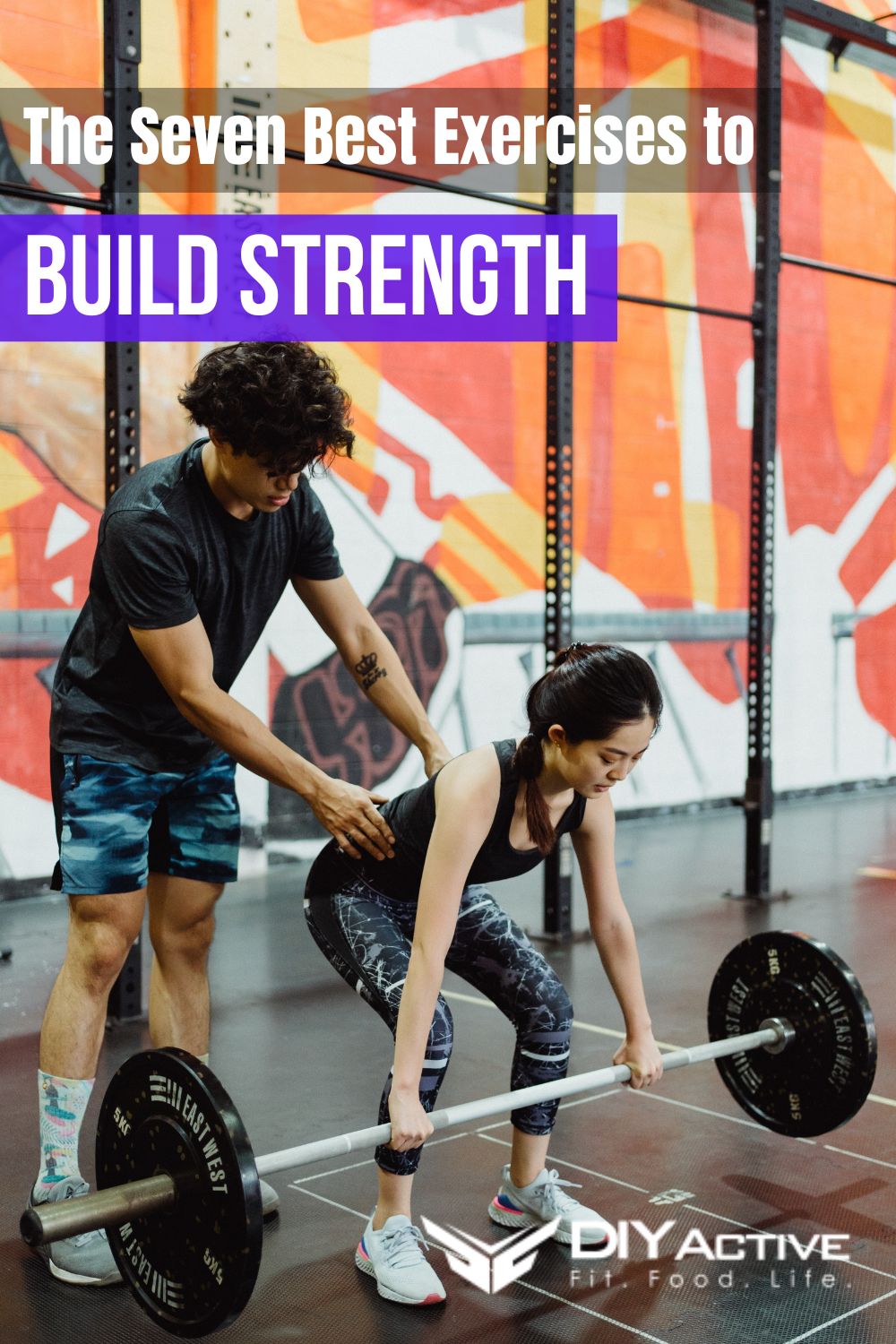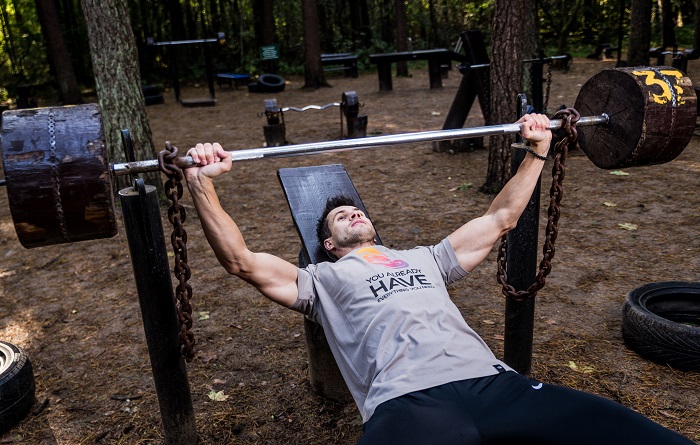Products You May Like

One of the primary reasons people go to the gym is to gain muscular strength. When it comes to building strength, not all exercises are built equally.
How to Get Stronger with 7 Simple Exercises
You can easily get stronger with seven simple exercises. But before we talk about the best exercises to build strength, we have to understand how muscular strength differs from muscular size, and the most efficient methods to build strength.
Strength Does Not Equal Size
A common cliche you often hear in relation to going to the gym is that you’re going to “get big and strong.” While this is often the goal for many people, it’s worth noting that muscular strength and muscular size aren’t the same thing, and need to be trained differently.
Both strength and size are specific adaptations, although not mutually exclusive. Muscular strength is a function of a) how proficient you are at executing a specific movement, such as a squat, and b) the amount of force that the muscles involved can produce.
Proficiency comes as your nervous system adapts to the movement since each different exercise is a unique skill. The ability to produce force increases as each muscle included in the exercise gets bigger, which is why muscular size is still important to consider for strength purposes.
Gaining muscular size, known as hypertrophy, is accomplished by putting sufficient tension on specific muscle fibers in order to initiate the process of tissue growth. When you perform bicep curls, for example, the fibers of your biceps are acutely damaged, which sends a signal to your body to grow those specific fibers so that they can accommodate that same stress in the future.
So while size does contribute to strength, it’s only half of the picture: you must consistently practice each lift you want to get stronger at so that your nervous system can adapt to performing that exercise in the most efficient manner.
When it comes to getting stronger with seven simple exercises, it’s important to pick the best exercises to build strength and stick with them over long durations of time.
Compound Your Efforts
When your focus is building strength, the best exercises to choose will be compound lifts, meaning they will recruit muscle fibers across multiple joints versus a single joint. Think of a deadlift, which recruits your entire posterior chain (glutes, hamstrings, spinal erectors, etc.) versus a simple leg curl, which basically just recruits your hamstrings.
By recruiting multiple muscles, you’ll be able to produce larger amounts of force, allowing you to lift heavier weights. It’s much easier to gauge increases in strength on compound lifts due to how complex the movements are.
They may not seem incredibly intricate, but your nervous system will be working much harder to create a more efficient movement pattern on a compound lift versus a simple isolation exercise.
The resulting increases in strength can then assuredly be chalked up to becoming more proficient in the movement, an increase in force production by the muscles included, or both.
And as we learned earlier, this is the very definition of what strength is.
Anatomically Correct
Now we know that we need to carefully select compound lifts that recruit the most muscle fibers possible and practice them frequently to build the most strength. Let’s take a quick detour to the world of Functional Anatomy to learn how to get stronger with seven simple exercises.
Your chest, formally known as your pectoralis major, is one of the largest muscles of your upper body. The primary function of the pec is horizontal adduction/flexion, which is the act of moving your upper arm towards and across your chest while in a horizontal plane. This is effectively trained when performing pressing movements involving the chest.
Accordingly, a bench press would be one of the seven best exercises to build strength.
Another large muscle of the upper body is your latissimus dorsi, the wing-shaped muscle located on your back. Your lats have two primary functions: shoulder adduction (moving the upper arm down towards the side of your body) and shoulder extension (moving the upper arm towards the rear of your body).
Adduction can be accomplished with a pull-up and extension can be accommodated with a row.
The final major muscle group of the upper body, the deltoids, is primarily responsible for shoulder abduction, which is essentially the reverse of shoulder adduction. An overhead press accomplishes this function.
Shifting to the lower body, the gluteals are the largest muscle in the human body. The glutes are primarily responsible for hip extension, especially when the knees are bent. Hip thrusts mimic this function, making it a perfect lower-body strength builder.
To round out the lower body, there are two more major muscles found in the legs: the quadriceps and the hamstrings. Their main functions are knee extension and hip extension, respectively. For the quads, squats provide the best method to adequately load a knee extension.
We mentioned hip extension as a function of the glutes above, but the hamstrings provide most of the force during hip extension when the knee is not bent. This means a deadlift, which is performed with much less bend in the knee than a hip thrust, will properly accommodate this function.
To recap, the seven best exercises to build strength are:
Bench Press
Pull Up
Row
Overhead Press
Hip Thrust
Squat
Dead Lift
Many variations of these movements exist, so pick the ones that best fit your current fitness level and equipment availability. A comprehensive list of variations can be found here.
Hit the High Notes
Now that we know how to get stronger with seven simple exercises, we also have to know how to use those exercises. Specificity is key here as well.
Performing these lifts at a high intensity with a high frequency will be key in developing strength. High intensity does not only mean a high level of perceived effort; intensity describes the percentage of your one rep max (1RM) that you’re using on the lift.
High intensity means a high percentage of your 1RM. A common strategy is to do three to five sets per exercise with a weight that you can safely perform three to five reps per set with.
Keeping with the “three to five” paradigm, you can work up to performing each exercise three to five times a week. This may seem high, but a high frequency for these movements will allow you to become as efficient at performing them as possible, which will greatly aid in strength progression.
Photo by Frame Kings
Photo by Ketut Subiyanto

